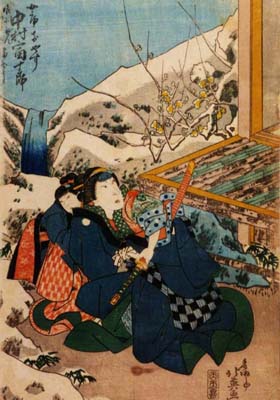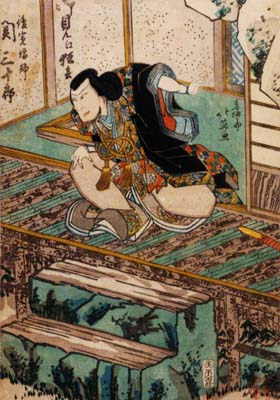| HIME KOMATSU |
| Play titles | Hime Komatsu Ne-no-Hi no Asobi Outing to Pick Pine Seedlings on The Rat-Day of the New Year [1] |
| Common titles | Hime Komatsu Shunkan Shima Monogatari Hora-ga-Dake no Shunkan |
| Authors | 1757 puppets version: Yoshida Kanshi I Chikamatsu Hanji Miyoshi Sh˘raku Chikamatsu Keiri Takeda Koizumo II 1758 Kabuki version: [2] Namiki ďsuke Sawamura Sh˘gor˘ Namiki Eisuke I Namiki Wasuke Matsuda Hyakka |
| History |
The play "Hime Komatsu Ne-no-Hi no Asobi" was originally written for the puppet theater (Bunraku) and staged for the first time in the 2nd lunar month of 1757 in ďsaka at the Takemotoza. It was adapted for Kabuki the next year and staged for the first time in the 1st lunar month of 1758 in ďsaka at the Naka no Shibai [casting]. This play was popular during the Edo period. It fell into oblivion [3] but it could be a very good candidate for a revival at the National Theatre in the future to come! "A Shingon priest (1143~1179), who was an anti-Taira conspirator, and a tragic exile. The story of Shunkan (1143-79) appears in literature, drama, and art. An administrator of Hossh˘ji, Shunkan was allied with the circle of retired Emperor Goshirakawa (r.1155~1158) who plotted against Taira Kiyomori's (1118~1181) rule at the Shishigatani villa in 1177. Shunkan, along with co-conspirators Fujiwara no Naritsune and Taira no Yasuyori was exiled to Kikai-ga-Shima, south of Kyűshű. According to "Heike Monogatari" (The Tale of The Heike), a year after banishment, an amnesty was declared and although Naritsune and Yasuyori were pardoned, Shunkan was forced to remain on the island. The Tale also tells of Ari˘maru, Shunkan's young disciple, who traveled to the distant island after hearing that Shunkan would not be pardoned. Finding the old man in a ravaged and beggarly condition staggering along the beach, Ari˘maru took Shunkan back to his tiny grass shack where the old man died. The dramatic moment when the imperial messenger arrives with pardons for Naritsune and Yasuyori and takes them from the island, leaving Shunkan alone, is the subject of the N˘ play "Shunkan". The story was considerably amended in Chikamatsu Monzaemon's (1653~1724) j˘ruri, "Heike Nyogo no Shima" of 1719, in which Shunkan receives a pardon but nobly decides to stay on the island so that Naritsune's islander wife can accompany him back to the capital. The envoy forbids this but Shunkan kills him and remains on the island. The Shunkan theme was further elaborated in the j˘ruri, "Hime Komatsu Nenohi no Asobi" of 1757 by Yoshida Kanshi, also called "Hora-ga-Dake no Shunkan", best known for the episode known as "Shunkan Shima Monogatari". In this version, the morning after Shunkan was left alone, a secret messenger came to tell Shunkan that Taira no Shigemori (1138~1179) forgave him and thus Shunkan secretly returned to the capital and lived in hiding at Hora-ga-Dake under the name of Raigen. Later he helped the imperial concubine Kog˘ no Tsubone escape from Kiyomori's oppression to bear a son." (jaanus) "In the Kabuki play Shunkan manages to escape his island exile on a secret mission to guard the emperor's concubine Kog˘ no Tsubone while she gives birth to a royal heir in a remote retreat at Horagadake. Since they will need a midwife, Shunkan enlists the services of a village girl called Oyasu, who fortunately is a secret supporter of the Genji cause. Oyasu wishes to learn the true identity of Shunkan and the noblewoman who is to give birth. In order to demonstrate her trustworthiness, she is about to swear an oath of secrecy on a pair of metal hand-mirrors, just as a warrior would swear on his sword. Fearful of revealing his secret, Shunkan stays her hand, but as he catches sight of his aged features in one of the mirrors the story of his lonely banishment inadvertently slips out. With Oyasu's assistance the little prince is born safely into the world." (from "The Actor's Image") |
| Structure |
This play was originally made up of 5 acts. The most famous scene, "Shunkan Shima Monogatari" (literally Shunkan Island Story-telling), was the kiri of the third act. |
| Key words |
Fujiwara Naritsune Gidayű Ky˘gen Jidaimono Maruhonmono Monogatari Shunkan Taira Kiyomori Taira Shigemori Taira Yasuyori Tokiwa Gozen |
| Summary |
|
| Notes |
[1] The title "Outing to Pick Pine Seedlings on The Rat-Day of the New Year" comes from "The Actor's Image". [2] We(ve found the list of sakusha for the Kabuki program at the Naka no Shibai in the 2nd lunar month of 1758 and it is very likely to be the same as for "Hime Komatsu Ne-no-Hi no Asobi", which was the previous program. [3] Last record in ˘shibai in March 1899 T˘ky˘ at the Ichimuraza with Kataoka Ichiz˘ III and Ichikawa Metora II playing the roles of Shunkan and Oyasu. |
 |
 |
|
The actor Nakamura Tomijűr˘ II and Seki Sanjűr˘ II playing the roles of Oyasu and Shunkan (the child was played by Arashi Kitsuz˘) in the drama "Hime Komatsu Ne-no-Hi no Asobi", which was staged in the 8th lunar month of 1835 at the Naka no Shibai (print made by Shumbaisai Hokuei) |
|
|
|
| Contact | Main | Top | Updates | Actors | Plays | Playwrights | Programs | Links | FAQ | Glossary | Chronology | Illustrations | Prints | Characters | Derivatives | Theaters | Coming soon | News |